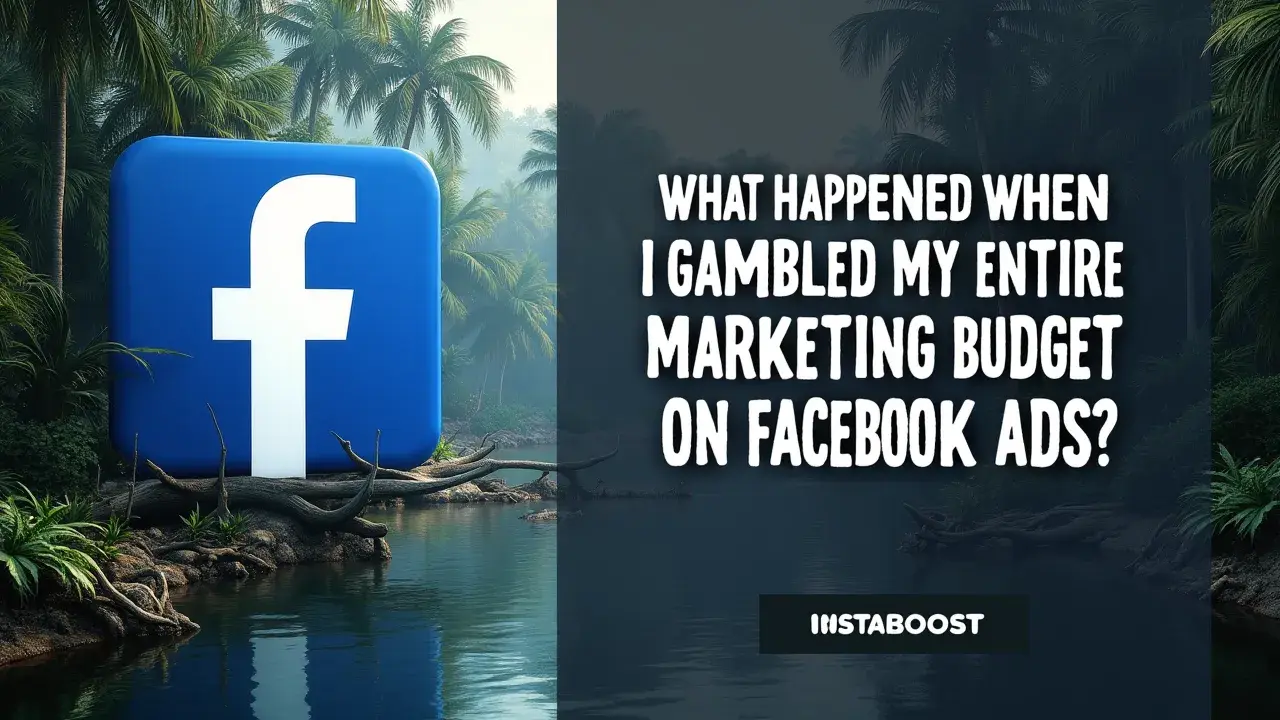What Happened After Betting the Marketing Budget on Facebook Ads?
Concentrating the full budget on Facebook Ads can expose weak links while revealing where scale is possible. Pushing spend for a month often stresses tracking, creative fatigue, and audience overlap, while highlighting campaigns that maintain efficiency as budgets rise. The uncomfortable math lies in rising CPAs versus incremental revenue and the point where marginal returns flatten. A smart path is testing lift, monitoring blended metrics, and scaling only where unit economics hold.
The Day I Bet the Farm on the News Feed
I put the whole marketing budget into Facebook ads. No starter test, no half-measures. Not because I enjoy risk, but because I learn faster when the stakes are clear.
The plan was straightforward: if Facebook really converts the way everyone says, one focused push with clean signals and tight feedback should prove it. If not, I’d see it in the numbers. I set simple rules: one business goal (qualified member growth for a niche Facebook group), one conversion event, and one spreadsheet to tell me if it was working. At first, the targeting looked eerily good.
Then the spend started slipping through cracks I didn’t see. Two creatives with the same message pulled in opposite directions: one grabbed attention with a high CTR but delivered weak leads; the other was plain and a little dull but drove solid members. Interest stacks that everyone recommends didn’t hold up. A basic lookalike and a clear landing page did. I watched frequency climb, CPMs swing around, and “learning limited” stretch into something that felt like it would never end. It wasn’t a clean win or a clean loss.
It was the middle: inventory that moved under my feet, attribution that didn’t line up, and the reminder that “scale” mostly means new problems show up. This series is the autopsy and the blueprint: how I screened out tire-kickers before they clicked, which creatives brought in the right people, the audience structures that stayed stable, and the setup tweaks that turned a campaign that was burning cash into one that grew a real community. If you care about the right members, not inflated click counts, here’s what failed, what actually scaled, and what I won’t repeat next time and, for what it’s worth, the gut checks that helped me step up your Facebook game without chasing ghosts.

Why You Should Trust My Gut Over the Dashboard
Sometimes the traction doesn’t show up in dashboards – it shows up in replies. I’ve run enough paid social tests to know that when a platform says it’s in the “learning phase,” it often means you don’t have signal yet. For this Facebook push, I treated the spend like a lab budget: structured ad sets, clean UTMs, and a short list of hypotheses I was ready to kill quickly. I’ve managed seven-figure funnels, built product-led growth loops, and watched attribution break when email, search, and Facebook retargeting all fired at once.
So when click-through rates dipped but the replies got longer and more specific, I didn’t panic – I changed what I counted as a conversion. That wasn’t bravado; it was pattern recognition from campaigns where a 1.2% CTR still worked because the comments read like mini case studies, and where the real signal often hid behind vanity metrics and threads debating whether to buy Facebook profile followers or earn them through compounding content. I also set a cold control: a zero-interest lookalike and a broad, no-interest audience to check the targeting. If broad beat the fancy segment, I paused the theory and went with the numbers.
The credibility isn’t that I pushed the whole budget into Facebook; it’s that I set it up so the downside taught me something I could use. Every creative had a clear job: a hook to stop a cold scroll, proof for people who needed receipts, and one “ugly” ad built to pull long-form feedback from the exact ICP. My north star wasn’t ROAS; it was speed to clarity. That’s how you tell a shiny spike from a durable signal in paid social, and how you end up with a Facebook group that sticks around after the coupon is gone.
Designing for Drift: Guardrails, Not Genius
Most plans don’t explode; they wander. The only way I kept a full marketing budget from leaking into Facebook Ads was by putting guardrails on it that pulled spend back to reality every 24 hours. I split campaigns by intent, not demographics: one track for “hand raises” like comments, DMs, and replies; one for revenue signals like checkout starts and purchases; and one for community growth through Facebook group joins. Each track had its own budget cap, target CPA ceilings, and a simple kill switch: two days over threshold or 0.5x target ROAS, and it paused automatically. Creative wasn’t a show-and-tell; it worked more like a review.
Every asset came in with a specific hypothesis – for example, hook X should lift thumb-stop rate by 20% for audience Y – and I judged it on scroll depth, saves, and reply rate before I worried about purchases. Targeting got the same treatment. Broad with smart exclusions beat narrow slices, and I layered negative targeting to keep out bargain hunters and serial freebie seekers. Aligning attribution windows with how people actually buy turned out to matter more than I expected.
I ran 7-day click for higher-consideration offers and 1-day click for impulse hooks, then checked cohort lag in GA4 so Facebook didn’t take credit it hadn’t earned. And because I was building a high-signal community, the best lever wasn’t a lookalike; it was the intake form. I added qualifying questions to the Facebook group and retargeted only approved members with product education. That filter cut CPA by a third and lifted downstream conversion, turning a noisy Facebook ads setup into a system that nudged itself back on track before my instincts did, most days anyway – the same way I dismissed vanity detours like buy Facebook likes and kept attention on signals that compound.
The Moment I Called BS on “Learning Phase”
Honestly, I almost quit right there. The Facebook dashboard made it look like my whole budget was going to toddlers: 0.6x ROAS, junk placements, CPM falling off a cliff. Pushing back felt risky until I started treating the algorithm like a junior analyst who needs guardrails and proof. I cut the interest targeting that was overfitting to past buyers, went broad with server-side events only, and split attribution: 1-day click for revenue, 7-day view for community.
Then I stopped chasing cheap clicks and ran a stubborn split test: two creatives meant to surface “hand raises” in the comments – people asking real questions – versus two aimed only at triggering checkout starts. The rule was simple: if the comments mentioned pricing, timeline, or integration, that ad kept spending even if the CPA looked bad for 48 hours, because those replies usually turned into purchases the dashboard didn’t catch yet, and I reminded myself that vanity metrics like boost your reach: buy Facebook views don’t translate to intent the way real questions do. Anything with shiny CTRs but low-quality DMs got parked in a learning set with a hard $50/day cap.
That pushback changed the picture: the “loser” ad dragging our blended CPA was actually filling the Facebook group with buyers-in-waiting, and the “winner” with friendly CPMs was mostly attracting tourists. If you’re running Facebook ads, don’t let automated optimization tell you what success is. Write your own rubric, wire it into budget caps and kill switches, and let human signal override machine comfort. That’s how you stop measuring noise and start buying progress.
The Only Metric I’ll Ship With Next Time
What I do next is the real story. After running my whole marketing budget through Facebook, the main lesson was simple: commit to a weekly decision, not a dashboard. The platform will always give you a good-looking slice of the truth – learning phase, audience expansion, modeled conversions – but a steady cadence helps: every Friday, make one irreversible change with a clear constraint.
That might mean moving 20% of spend from “community” to “revenue” if blended CPA drifts 15% over target, or cutting a creative that’s cheap on CPM but loses on first-order profit. I still split by intent and kept the guardrails – budget caps, CPA ceilings, kill switches – but the shift was treating each week like a release cycle with one owner, one bet size, and a written rollback plan. In practice, that looked like de-duping attribution across channels with server-side events, setting a clean 1-day click window for purchases, and using 7-day view only to guide group growth and nurture, the same way I treat the social bump you get when you amplify your post visibility as a signal rather than an outcome.
It also meant changing the goal: not “scale,” but “option value” – creatives that raise click quality across campaigns, landing pages that shorten payback, and audience structures you can carry to search and TikTok. The ending isn’t a polished ROAS chart; it’s a system that gets through bad weeks without burning the compounding ones. If you’re about to push your budget across the table, write the one metric you’ll ship with on a Post-it first. Then make the platform earn next week’s bet. That’s how a gamble starts to look like a plan, and how Facebook stops deciding your P&L… and starts reflecting your operating cadence.















